That last one was a scorcher! In Santa Ana, it set an all-time record at 114. In Riverside, it got up to 118. Ojai hit 110. In the shade of my front porch in Ramona, San Diego County, it reached 113. July 6-8, 2018 was a spell for history.
It was so hot that it burned native live oak trees. Never seen that before.
As far as the garden goes, I won some and lost some. I have seen and heard from many others up and down Southern California who had the same results — the exception being anyone who lives within a couple miles of the beach. They only heard about the inland heat.
This post is about what we’ve done right and wrong in caring for our vegetables and fruit trees during the intense heat. The goal is to help us get through the next heat wave better.
Water
First and foremost, water everything, and do so before the heat wave hits. Compare two of my grapevines. I had watered this young grapevine deeply just before the heat hit on Friday, July 6. It took the 113-plus-degrees in stride.
But I didn’t get around to watering this grapevine until the heat was already upon it. Obviously, this was too late.
I’ve seen this strategy of watering thoroughly before the heat hits work very well on any and all vegetables and fruit trees during this last heat wave as well as during previous heat waves. It just works. I know this much firsthand.
Why does it work? As one University of California soil scientist and irrigation expert explained it to me, when the heat gets severe the plant is unable to take up water through its roots — just when it needs that water most. The plant stops transpiring (exhaling water from, mostly, its leaves), which is necessary in order to draw water into its roots. In essence, the plant shuts down.
However, if the plant had had ample soil moisture available to it before the severe heat hit, then the plant would have fully hydrated itself and be as fortified as possible to tolerate the heat and suffer as little damage as possible while it was shut down. You are preloading the plant before the stress.
It’s akin to the advice your mother gave you to eat a good breakfast before you start a busy day.
Secondly, water some plants during the heat wave. In my experience, most vegetables and avocados usually need irrigation daily when the mercury rises into triple digits. This was certainly required with last week’s record heat. For the most part, this is because most vegetables and all avocados are relatively shallow rooted.
In contrast, I watered my citrus trees just before the heat and found no need to water them again during the heat. Same with peaches and plums and other deciduous fruit trees. I felt the soil under all of these trees amidst the heat wave and found it still plenty moist.
Beware of any trees on drip irrigation though. They’re likely to need daily water when it’s 100 since trees on drip irrigation generally have limited root systems.
One last thing: Wetting a plant’s leaves gives it relief from heat stress. If you’re around and able to do it, then spray down the foliage of plants that are wilting even though they have moisture in the soil below; you’ll see them perk up immediately.
Shade
Protect plants by shading them if you can. Use whatever is on hand: a chair, a table, a beach umbrella, a tomato cage covered in shade cloth. This baby avocado tree came through the intense heat perfectly because I shaded it:
Other larger avocado trees were impossible to shade, and some of their leaves burned despite the plentiful water I gave them. Avocados are not built to withstand 110-plus degree heat and low humidity.
Here are the crispy leaves of an adjacent avocado tree that I didn’t shade:
(For avocado-specific guidance see my post, “Protecting avocado trees from heat.”)
Here is a video tour of some of my avocado trees and the damage they incurred on July 6 and 7, 2018:
Shading works, and it’s easy to do for small plants. But is there anything we can do for big ones?
Spray clay?
There is the option of spraying a protectant on the foliage. One such product is called Surround WP. Some farmers use this kaolin clay spray and it appears to be effective at preventing sunburn while also not harming the plant’s ability to grow. It’s even claimed that this clay film protects against some insect damage.
Growers of mangos near Indio spray the leaves of their trees with such a clay product. I also noticed during this heat wave that one of the vineyards in my neighborhood had been sprayed with clay, and the vines look like they appreciated it.
I’ve never tried this clay spraying, but if it gets up in the 110s again soon I just might.
Aftermath
What to do about the burned leaves after the heat has subsided? With most plants, like bananas or blueberries, you can remove the burned, dead leaves. With avocados, however, leave them alone for a while. You don’t know exactly how far back on a branch the damage has occurred until new growth starts sprouting — that could take a month or more — and the dead foliage might be beneficially shading branches below. Avocados are so sensitive to sunburn that this is useful temporarily. Immediately paint any exposed bark. (See my post, “Avocados trees get sunburned — what to do?”)
If a young avocado tree has had most of its leaves and branches burned, you might consider replacing it. A new tree is likely to outgrow such a damaged tree even if the damaged tree does ultimately recover. I’ve found that severely damaged young avocado trees are very difficult and slow to bring back to health.
Also for a severely burned avocado or any other type of plant, remember that its water needs will be lower since it has fewer leaves. It’s mostly the leaves that cause the roots to suck up water in the soil. If you continue watering a damaged plant as much as you had before, you might find yourself with soggy soil and diseased roots.
Again, in summary, water everything before the heat hits, water some plants during the heat, and shade what you can. That’s the best strategy of protecting plants during heat waves that reach well over 100 degrees.
(You might also like to read University of California Farm Advisor Ben Faber’s perspective on this heat wave from Ventura and Santa Barbara: Frost Damage in July?)
Update: August 20, 2018 (six weeks after record heat of July 6)
The effects of the extreme, record heat of July 6, 2018 have been revealing themselves incrementally over the succeeding month and a half. Some of them were expected. Exposed fruit were sunburned. I saw sunburn on apples and avocados mostly.
Some avocados also dropped. In fact, over the weeks I lost hundreds of small Reed avocados from a single tree that had a huge fruit set going into early July even though it held onto all of its mature fruit. The neighboring Lamb avocado tree lost very little of its fruit, however, and I don’t know how to explain this combination of consequences. I’ve seen that some of you have experienced variable and sometimes perplexing fruit drop on avocados and other fruit trees too.
Burned foliage on plants and trees has dried up and started falling off. Many new leaves have started to grow on healthy plants. My burned grapevine above has recovered foliage. My avocados have grown new leaves. It’s now time, finally, to safely cut out the dead stuff.
A few fruit trees have responded to the heat stress by flowering. First, my apples bloomed. These are Fuji and Pink Lady apples, not Anna or Dorsett Golden (varieties which practically bloom all year long).
Now, my Kishu and Pixie mandarins are also flowering. My Bearss lime is flowering too, but limes and lemons are always flowering so that’s nothing remarkable.
On July 9, I felt relief that the heat had subsided, but since then it has been a month and a half of new damage unexpectedly showing up. You think, Aaaaaah!, the heat is finally over, but the consequences of that heat continue to manifest.
Let’s not be surprised if it lasts for a full year or more. Some trees grow flowers and fruit on wood that has developed the previous summer. So if this summer damaged such wood, we might be in for a zero-to-low crop on the tree next year. The drama has yet to stop unfolding.
All of my Yard Posts are listed HERE

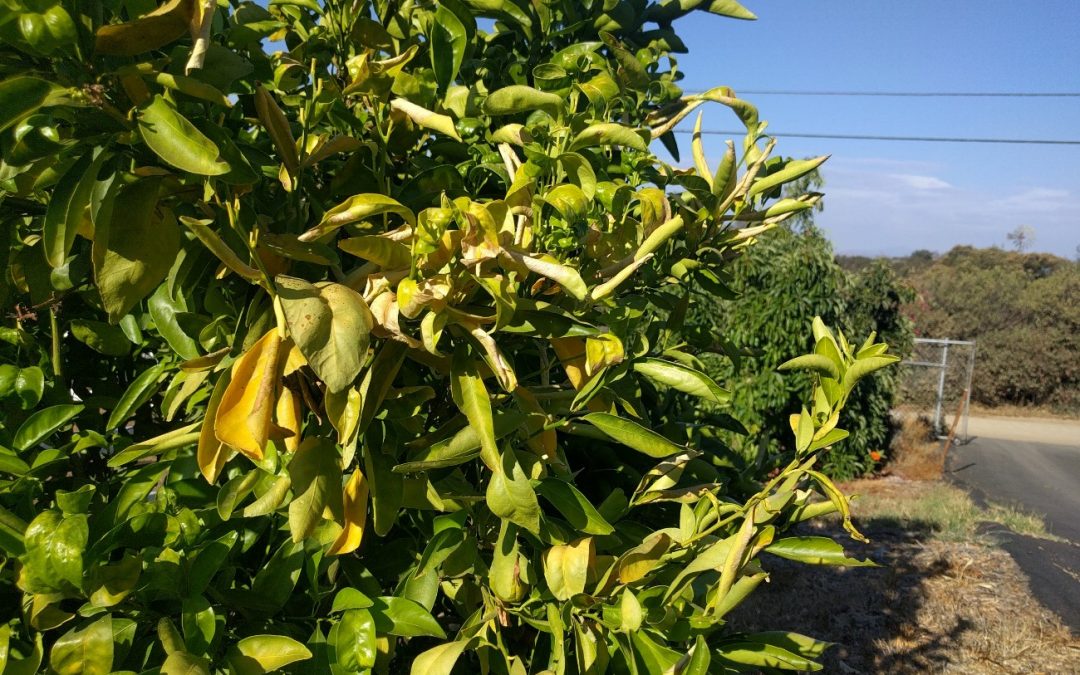


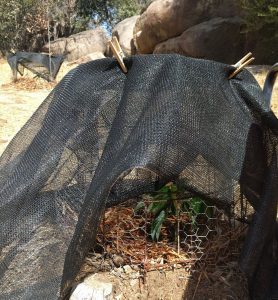
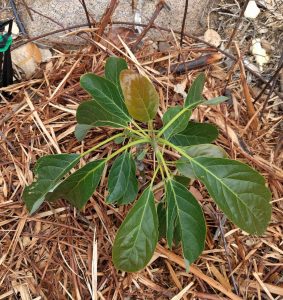
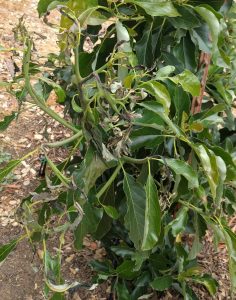
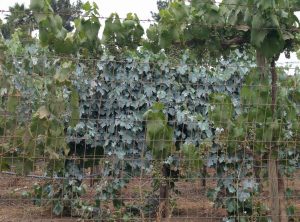
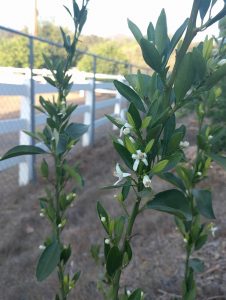


It makes me feel a bit better to see that an expert gardener’s trees are also kind of sad-looking after this heat wave. I’m a complete newbie and furthermore a non-weather forecast watcher and I bought my first avocado trees the weekend before and haven’t had time to plant them in the ground yet. Oops.
When you said about the avocado trees that “You don’t know exactly how far back on a branch the damage has occurred until new growth starts sprouting” what does that mean in relation to not removing dead leaves? I bumped into a low branch of one of mine while watering and that made some of the leaves fall off ?
Hi Erin,
What luck with your brand new trees and the heat wave! So sorry.
What happens is that the burn damage on a branch will not be clear or complete right after the heat wave. Sometimes more damage becomes apparent a few days or even a few weeks later. So for avocados, you immediately paint any exposed bark, and then you sit back and wait and hope that the burn damage doesn’t grow.
You should not remove dead leaves because whatever leaves and branches that are below them are used to being shaded by them. So let the dead leaves slowly curl up and dry up and crumble. That way the lower leaves and branches will gradually get used to the new, extra sunlight.
Update: the trees have been painted and planted and they’re already starting to grow new leaves all over. I’m happy!
Thanks for all your blog posts I really enjoy them and they are quite helpful!
Hurray! Great news. Thanks for the update.
Does watering the new flush in severe heat conditions prevent the leaves from being consumed.
Hi Robert,
I’m glad you asked. This is something I’d considered including in the post.
Technically, yes. Watering the foliage of an avocado tree or any other plant cools it and also raises the humidity in the immediate area and so can prevent the leaves from being damaged.
The trick is that the foliage has to be sprayed off and on continuously for this to be effective. If you have the time to do so, great. If you have an automatic system that can achieve it, even better. I’ve read of commercial farmers finding it effective to wet foliage for 15 minutes out of every hour. (See this article: http://www.avocadosource.com/CAS_Yearbooks/CAS_82_1998/CAS_1998_p137-154.pdf)
I wetted the leaves of many plants many times during the extreme heat of July 6 and 7 and was amazed at two things: how quickly the leaves responded and regained turgor; and how quickly the water dried and the leaves resumed wilting. I saw that it was futile unless I was capable of doing it more or less continuously.
Still, I have to admit, it feels good to see your plants get a few brief moments of relief on days like that even if it does no significant protection.
Thank you for such great information. I live in North Orange County. I have 4 citrus and one avocado that are full of suckers. I want to remove them but wonder if I should wait until the weather cools off.
Hi Jodie,
That’s a good question. I would wait a couple days until this heat passes just because the suckers might be shading some branches that will get burned. Around mid-week, cut out the suckers and immediately paint any branches as necessary.
Is there a preferred time of day to water avocado and citrus trees? I’m in villa park!
Hi Ara,
Is this watering being done during a heat wave or anytime?
One rule that always applies is that if your tree is thirsty, water immediately. Doesn’t matter what time of day it is.
More the heat wave. Lately I’ve been watering anywhere from 6-9 pm. Maybe too early? During the cooler months I usually water around 7am. My baby avocado tree fried from that first heat in July and I think a lil more yesterday. Basically just the bottoms are alive at this point and there are new shoots coming out
Thanks,
Ara
I actually wrote a post called, “What is the best time of day to water your plants.”
The short of it is that you’ll save a little water by not watering in the middle of the day (less evaporative loss), but during a heat wave you might actually want that evaporative loss. I often run my micro-sprinklers under my avocado trees for 30 minutes or so in the middle of the day when it’s exceptionally hot (at least 100) because it raises the humidity slightly and cools the immediate area slightly. This reduces the trees’ stress a little. But then when I actually want to get water down to the trees’ roots, I water for longer and at a cooler time of day.
My very old Avocado tree in the back yard was damaged with the high heat in July. Avocados were growing on the tree at that time. It’s now September and the same fruit is still on the tree. A very small amount of them turned black and fell off the tree. But the rest – and there are many many of them still on the tree with no apparent damage other than the fact that they are still the same size they were 2 months ago which is about 3-4 inches in length. Should I continue to water the tree or give up?
Hi Vicki,
Sounds like the tree and fruit are still growing and you shouldn’t give up. Young avocado fruit doesn’t grow at the same pace throughout its life so it might seem like the fruit isn’t getting bigger or more mature sometimes, but just be patient.
I painted my baby Reed and new baby, Hass. I didn’t water down the paint! Does it matter? I have a Fuerte that ‘ll be planted hopefully by the weekend, should I make sure to water down the paint? It is a small (old) sample tin and pale lemon -looks like a cream color. It’s what I had on hand for an emergent situation and didn’t want to go to the store.
Don’t worry about diluting the paint. It’s Ok if you do but not necessary.
Thank you! I was worried that I might have overdone it!